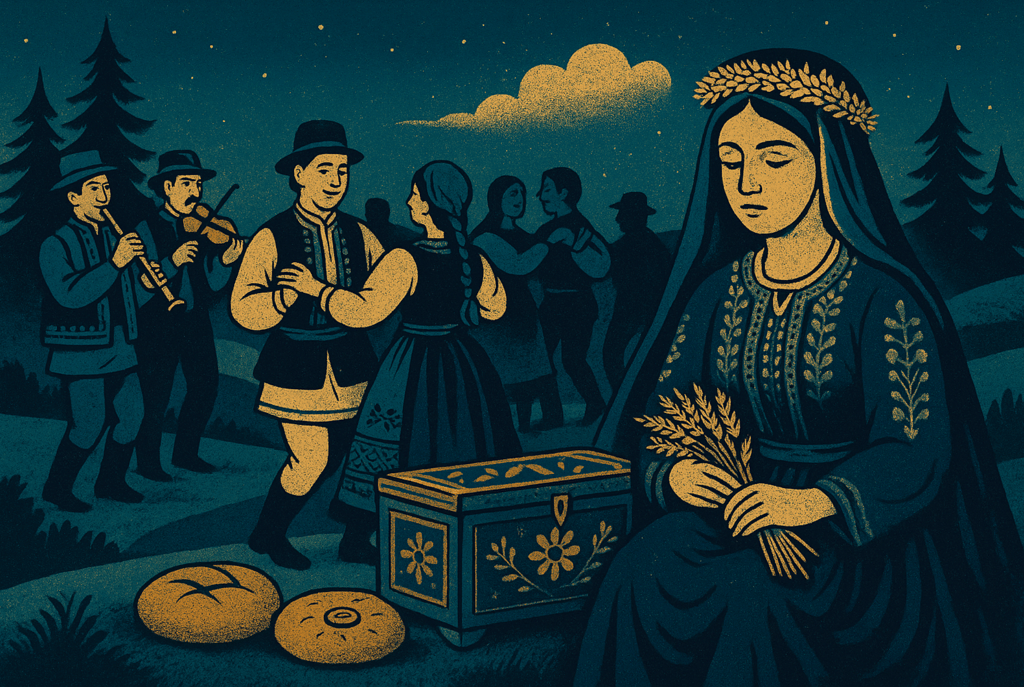Romanian Wedding Traditions Rooted in Folklore
Discover Romanian wedding traditions rooted in folklore - from ancient matchmaking to dances, blessings, and charms passed down through generations.
10/4/20253 min läsa


In Romania, a wedding is more than a ceremony - it’s a living museum of folklore. Beneath the embroidered shirts, the clinking glasses, and the swirling hora, every gesture hides an older meaning. Marriage, in traditional belief, wasn’t just the joining of two people - it was a sacred pact between families, ancestors, and the unseen forces that govern fate.
Before the Wedding Bells: Pețitul and the Matchmaking Ritual
Long before the wedding feast, a proper Romanian marriage began with the pețitul the formal matchmaking visit. The groom’s family would arrive at the bride’s home carrying bread, salt, and a bottle of țuică, speaking in riddles and metaphors.
In some regions, they’d say, “We’ve come with a fine colt looking for a good stable.” If the bride’s parents agreed, everyone shared bread and plum brandy, sealing the agreement in what was part blessing, part performance. This playful exchange echoed ancient fertility and abundance rites, still alive beneath the humour.
The Dowry Parade: A Festival of Skill and Pride
In Maramureș and Transylvania, the bride’s dowry used to be carried through the village on a decorated cart, led by fiddlers and singers. Handwoven carpets, embroidered blouses, and wooden chests, each item was proof of the bride’s skill, patience, and creative spirit.
At the heart of the procession stood the lada de zestre - the dowry chest, often carved with flowers, suns, or birds. Folklorists call it the “chest of dreams,” symbolising not just wealth but identity. It held the linens she had spun, the hopes she carried, and sometimes a handful of soil from her family’s land, a tangible link to home.
Hair, Crowns, and the Magic of Transformation
On the eve of the wedding, the bride’s hair was ceremonially braided by her godmother or closest friends, while mournful cântece de nuntă (wedding songs) filled the air. The act marked her transition from maidenhood to womanhood, a rite of passage that echoes ancient fertility rituals.
At the church, she wore a crown of wheat or myrtle, plants tied to abundance and eternal love. In Moldavia and Wallachia, the bride’s hair was often covered with a fine maramă, an embroidered veil that represented modesty and spiritual protection. The Orthodox crowning ritual that follows is, in many ways, a continuation of this pre-Christian idea: marriage as a divine coronation.
Bread, Salt, and the Circle of Joy
Few symbols appear as often in Romanian folklore as bread and salt. In many villages, the newlyweds are greeted at the entrance to the celebration by parents offering these two essentials. The gesture is more than hospitality, it’s a promise that their new home will never lack nourishment or luck.
During the feast, guests join hands for the hora miresei, the bride’s dance. The hora - a circular folk dance - is one of the oldest living symbols in Romanian culture. The circle represents eternity, unity, and the sun’s movement across the sky. Dancing together keeps evil spirits away and invites shared joy into the marriage.
Music of the Ancestors
Romanian weddings are symphonies of folklore. In Țara Lăpușului or Bucovina, fiddles, flutes, and drums accompany the traditional verses called strigături. These shouted rhymes mix humour, teasing, and blessing sometimes roasting the groom’s dance skills or the mother-in-law’s cooking, all in good spirit.
Each region has its own melodies: the mournful doina for partings, and the lively sârba or brâu for celebration. Together they form a kind of emotional journey - grief for the past life, joy for the new one - mirroring the transformation that marriage signifies.
The Bride’s Kidnapping - Folklore Meets Fun
No Romanian wedding is complete without the răpirea miresei, the bride’s playful “kidnapping.” Late into the night, the bride disappears, taken by friends who demand the groom “ransom” her back with drinks, money, or a public declaration of love.
The roots of this prank are surprisingly old. In some rural folklore, it mirrors ancient “bride capture” rituals, where the groom symbolically took his bride from her family’s domain. Today, it’s a theatrical nod to those ancestral customs, half comedy, half reminder that love has always been a bit of a chase.
Folklore Blessings and Protective Magic
A Romanian wedding traditionally lasted three days and each stage included its own blessings, songs, and superstitions. Guests sprinkled wheat over the couple for fertility. A red thread might be tied around the bride’s wrist to protect her from the deochi (evil eye). And the elders offered poetic blessings like:
“May your love be like the fir tree - evergreen, even in winter.”
These phrases might sound quaint today, but they reveal how folk belief and daily life were woven together. The wedding wasn’t just a party; it was an initiation into adulthood, witnessed by family, neighbours, and spirits alike.
The Living Heart of Tradition
Even modern Romanian weddings still echo with these ancestral sounds. A bride might wear a designer gown, yet her grandmother will tuck a coin into her shoe for luck. The DJ may play pop songs, but someone will always start the hora. And at the edge of the dance floor, the folklore still whispers that love, like the old songs, lives best when it’s shared in laughter, ritual, and community.
